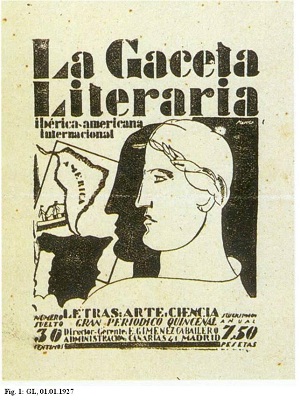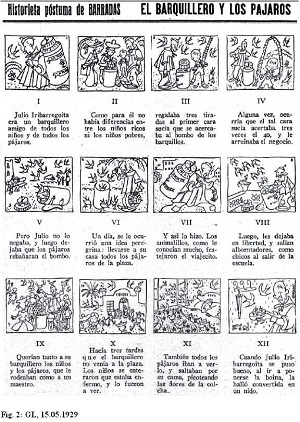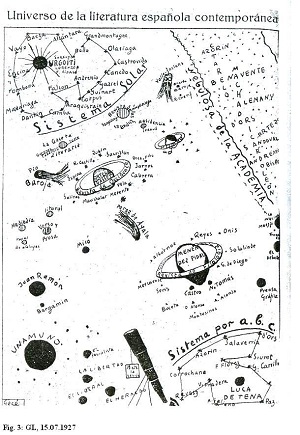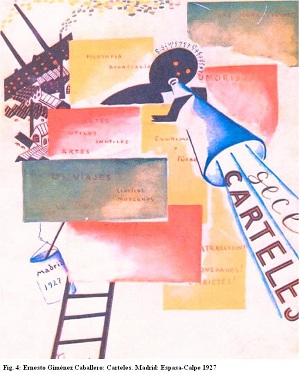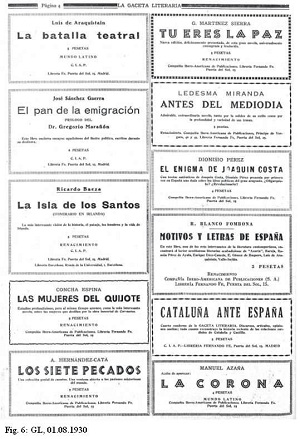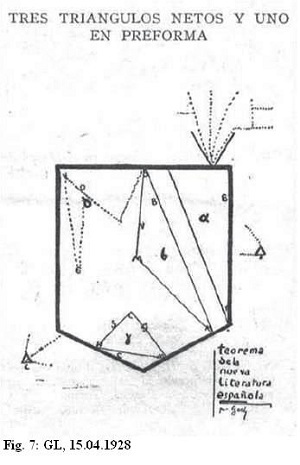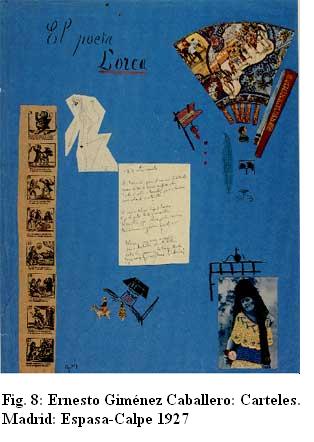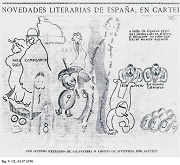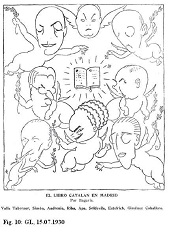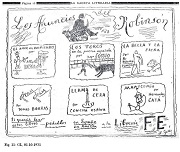|
Mechthild Albert (Bonn) Visual media in the Spanish avant-garde magazine La Gaceta Literaria (1927–1932) – between popular traditions and modern mass-cultureDie spanische Avantgarde, die sich 1927 im Rückgriff auf den Barockdichter Góngora konstituiert, ist grundsätzlich geprägt von der Koexistenz traditioneller und moderner, gelehrter und populärer Elemente. Diese spannungsvolle Dialektik lässt sich am Beispiel der Druckgraphik des Avantgarde-Magazins La Gaceta Literaria (1927–1932) veranschaulichen. Einerseits greift das Magazin auf traditionelle autochthone Medien wie die Bilderbögen des sog. Aleluya zurück, andererseits bietet es eine originelle Form zeitgenössischer Werbegraphik: In seinen "Carteles literarios" verbindet der Herausgeber, Ernesto Giménez Caballero (1899-1988), Kommerz und Ästhetik im Interesse der intellektuellen Produktion und der Verlagsindustrie. IntroductionFencing or football – it is in these terms that Ernesto Giménez Caballero (Selva 2000), one of the leading intellectuals of the Spanish vanguard and director of the influential magazine La Gaceta Literaria, couches the contrast between highbrow and popular culture in 1927. This socio-cultural opposition, exemplified by sports, is related to a generational change in the context of "un ambiente o panorama social nuevo" (Giménez Caballero 1927: 13). Above all, the views of young and old differ on questions of taste and attitudes in everyday life, ranging from hygiene habits to fashion, from cinema to cocktails. In view of these contrasts, Giménez Caballero, although belonging to the first row of the vanguard, takes up a position not of rift but of conciliation, proposing a 'transition', a 'bridge', between the contrasting cultural paradigms. So, obviously, the motto "Cross the Border – Close the Gap", formulated by Leslie A. Fiedler in 1972 as the essence of postmodernism, is valid for the vanguard, that is to say for 'classical' modernism. In fact, the Spanish vanguard stems from two sources: on the one hand, a highbrow tradition of learned rhetoric which reclaims for itself the baroque poet Luis de Góngora, whose 350th death anniversary is commemorated in the emblematic year of 1927, and on the other hand, from the reappraisal of traditional folklore which moulds itself into the so-called 'neo-popularismo'. None other than Federico García Lorca explains the relevance and convergence of these two complementary inspirations in his programmatic lecture "La imágen poética de Luis de Góngora", given at the homage in Córdoba. Several years later, almost at the decline of the Spanish vanguard, its profound interest in popular culture and folklore is reaffirmed by an event celebrated in May 1933 at the Teatro Español, featuring a conference by Rafael Alberti on "La poesía popular en la lírica española", followed by flamenco dances and songs performed by La Argentinita, accompanied at the piano by Lorca (Crispin 1997: 17). PhiN-Beiheft 6/2013: 12 In comparison to the international vanguards, the recourse to the (non-exotic, but autochthonous) 'primitivismo popular' is specific to Spanish modernism. As John Crispin points out in his essay on "Vanguardia, modernism(o) y primitivismo popular", the "Volksgeist" or, in the words of Unamuno, the cultural substratum of the 'intrahistoria', had been a decisive feature of Spanish modernity since Romanticism, gaining a particular importance in the realm of the generation of 1898 (Crispin 1997: 17). Modernism in Spain appears thus intimately linked to the idea of cultural continuity (Crispin 1997: 21), which even outweighs the revolutionary gesture of the vanguard. The dialectical synthesis between highbrow and folk or popular culture is thus a constituent part of the Spanish avant-garde movement in general, even if mass-cultural and elitist interpretations of it have been radically different. On the one hand, José Ortega y Gasset claims that modern art is essentially anti-popular in his essay La deshumanización del arte (1925); on the other hand, César Muñoz Arconada asserts that the vanguard aimed mainly at the refusal of 'the exquisite': "Lo que postulaba la vanguardia era la quiebra de lo exquisito" (Buckley/Crispin 1973: 397). As a mouthpiece of the Spanish vanguard, La Gaceta Literaria obviously reflects the intricate relationship between highbrow and popular culture. Taking for granted that this international magazine was mainly intellectual in its orientation, we will concentrate here, above all, on two outstanding aspects of popular culture that focus the use and function of popular graphic media in this avant-garde magazine: traditional graphic media such as aleluya, and modern popular advertising posters. Ernesto Giménez Caballero and La Gaceta LiterariaFounded by Ernesto Giménez Caballero with Guillermo de Torre as his secretary, the first issue of the bimonthly magazine La Gaceta Literaria is published on the first of January, 1927 (fig. 1).1
Fig. 1, Click on Image for Enlargement PhiN-Beiheft 6/2013: 13 The heading of the magazine declares that it is devoted to "Letras, arte, ciencia", its orientation being "ibérica, americana, internacional". It quickly becomes an important platform for intercultural exchange. The most renowned authors of the Spanish vanguard write for the Gaceta Literaria, among them Benjamín Jarnés, Ramón Gómez de la Serna, Antonio Espina and José Moreno Villa. In 1929, César Muñoz Arconada assumes the post left vacant by Guillermo de Torre, who had gone to Argentina together with his wife, the illustrator Norah Borges, sister of Jorge Luis. One year later, important changes take place: the growing politicization of Spanish society, together with the ideological turn of Ernesto Giménez Caballero, who became a forerunner of the fascist movement in Spain, lead to the substitution of the communist Arconada by the monarchist Pedro Sáinz Rodríguez; the magazine acquires a different source of finance and a new editor; the format becomes smaller, and the number of pages increases. More and more collaborators leave, due to a further ideological polarization, so that from mid-August of 1931, Giménez Caballero redacts some issues all by himself, calling them "El Robinsón literario de España". The magazine publishes its last issue without any explanation to the reader on the first of May, 1931. The magazine is open to a broad range of popular matters, from subjects common to the international vanguard such as fashion and jazz, to autochthonous ones such as the bullfight or flamenco.2 Other themes of popular interest were football, 'covered' by the humorist author and film director Edgar Neville and, of course, cinema, with Luis Buñuel reporting from Paris film premières and publishing his early thinking on the aesthetics of cinema. Giménez Caballero, himself the director of a documentary on the popular funfair "Verbena de la paloma", organised the magazine's own Film Club, where recent international films were projected, among them a series of comical films which inspired Rafael Alberti to write his poems on Charlie Chaplin, Harold Lloyd and Buster Keaton, first published in La Gaceta Literaria. This passion for the cinema – the '7th art', to which the magazine dedicated a special issue, is but one aspect of the relevance and popularity visual media gain in the first decades of the 20th century. Therefore, La Gaceta Literaria, being a modern magazine, is very much concerned with its own visual presentation: beneath photos – of rather bad quality, alas – it has at its disposal an important series of prestigious contemporary artists providing it with illustrations; here one could mention José Vázquez Díaz and Rafael Barradas, Gabriel García Maroto, Lluís Bagaria and Salvador Bartolozzi. It is in this context of a culture dominated by the visual that we have to consider the use of traditional visual media on behalf of the Spanish avant-garde intellectuals, who rediscover the artistic charm and the communicative efficiency of ancient popular prints belonging to the so-called 'cordel-literature', which includes genres like the "aleluyas", "coplas"3 and "romances". PhiN-Beiheft 6/2013: 14 Traditional visual media – AleluyaThe aleluyas can be defined as an archaic kind of comic (Martín 2005). Originally, they were stamps with 'Hallelujah' printed on them, which were thrown among the parishioners on Good Saturday. Later on, during the 18th and 19th centuries, these prints, like the French Images d’Epinal or the German Bilderbogen, became a sort of rudimentary encyclopaedia destined for the great masses of the illiterate and children, serving an entertaining as well as instructive purpose. The 48 cartoons per sheet had either no legend or a legend in rhyming couplets, or in narrative prose. The subjects consisted of history and geography, the biographies of illustrious men, views of famous cities, literary texts, children's games and traditional professions. The aleluya was held in great esteem among the Spanish avant-garde for a lot of reasons – including the predominance of the visual, the recent success of the comic strip, the experimental interest in the tension between old and new, text and image, or the playful possibilities of intermedial relations. But even the didactic function of the ancient media was not forgotten, for on February 15th, 1928, the Gaceta Literaria announced the publication of "popular biographies of writers", in the form of aleluyas, at the price of 10 céntimos: "Las aleluyas estarán escritas por jóvenes escritores y por artistas consagrados del dibujo. Comenzaremos por la Vida y obra de Vicente Blasco Ibañez, ilustrada por el dibujante Ferrer, de 'El Sol'." Unfortunately, we have no hint of how this project was realised, inspired perhaps by the death of the popular novelist two weeks previously. The popularity of the traditional visual media is illustrated by the fact that Papel de Aleluyas was the name of an ephemeral avant-garde magazine published in Huelva from 1927 to 28 by Fernando Villalón, Rogelio Buendía and Adriano del Valle.4 In this magazine, two articles discuss cinema in relation to the genre of the aleluya: (Albersmeier 2001: 225) in issue number 3, corresponding to April 1927, Ernesto Giménez Caballero publishes "Ecuación de la aleluya", where he establishes a curious 'genealogy' of the cinema, denoting the laterna magica as its mother being, and the aleluya as its grandmother. The cinema has much in common with this remote ancestress – especially its great effectiveness as a visual mass media, "[e]sa fascinación de muchedumbres", based on archetypical narrative strategies focused on adventure, on the hero and an exalted conception of life:
One year later,6 César Muñoz Arconada replies to Giménez Caballero, whom he compliments as "nuestro gran folklorista", with an article entitled "El cine de la aleluya". Here he completes the genealogy of the cinema with a pictorial and a literary reference, namely Goya and the pulp novel of the 19th century. Concerning these parallels, Franz-Josef Albersmeier speaks of the "update of the aleluya as a pictorial-poetical hybrid in the new medium film" and considers them to be a ludic element in the context of the intermedial experiments carried out by the avant-garde (Albersmeier 2001:225).7 In the same magazine Papel de Aleluyas, Ramón Gómez de la Serna, well known for his manifold literary experiments, presents an "absurd", slightly surrealist aleluya with the title "El espejo, el hombre y el conejo" (The mirror, the man and the rabbit). PhiN-Beiheft 6/2013: 15 When the great avant-garde, 'vibrationist' painter Rafael Barradas dies in February 1929 at the age of 39, the Gaceta Literaria publishes as a tribute two rather naïve "historietas" painted by him. One of the stories, "Amigote",8 is about two little boys starting out, without success, for a trip around the world; the other one, "El barquillero y los pájaros" (fig. 2),9 is about an old man selling wafers, a friend of children and birds. When he falls ill, the birds visit him, picking the flowers from his mattress and making a den in his beret, ideas very much in the spirit of the Spanish humorous avant-garde. These modest 'comic strips' correspond to one of the features of this versatile avant-garde painter, whose artistic activity was "escindida entre la necesidad de vivir y la de pintar en un estilo de limitada aceptación" (Estepa 2002: 189).
Fig. 2, Click on Image for Enlargement By matching the influence of cubism and expressionism with traditional popular elements, Barradas is one more example of the blending characteristic for the Spanish avant-garde. He works for Alfar, a highbrow avant-garde magazine, as well as for purely commercial periodicals. Together with Maruja Mallo and Gabriel García Maroto, his friend and illustrator at the Gaceta Literaria, he is counted among the populist artists of the Spanish avant-garde who, like Lorca in the literary domain, are immersed "en la sencillez del pueblo" (Estepa 2002: 192). In order to earn his keep, Barradas worked as a designer and illustrator; through this rather commercial activity, he helped to propagate the new aesthetic paradigm, since the commercial art of graphic illustration can be considered as "punta de lanza que abrió brecha en la diffusion de las vanguardias plásticas" (Estepa 2002: 189). His populist art even went to children as he designed toys and was responsible for the graphic design of the collection La Novela Rosa, addressed to a readership of young girls. In the complementary Almanaque Rosa para 1928, he published an 'aleluya' entitled "La Nena de la Luna" (Estepa 2002: 190–191), much in the same vein as the two "historietas" published by the Gaceta Literaria.10 PhiN-Beiheft 6/2013: 16 However, what we do 'not' find in the Gaceta Literaria are examples of, or references to, modern comic strips – with one exception, an ode to Felix the Cat by Carmen Conde which is related, of course, to the cinematic poems of Rafael Alberti, published in 1929 with the title Yo era un tonto y lo que he visto me ha hecho dos tontos (Gubern 1999). The early cartoon hero is addressed as "Gato 'trade-mark'. 'Made in U.S.A.' / Gato extrarradiado por el gran frontón del écran. […] Gato – acuarela de tinta china. / Gato de mil voltios. / ¡Oh, Gato Félix!".11 Modern graphic media – The literary posterOn July 15th, 1927, the Gaceta Literaria publishes the first sample of a new kind of graphic, a literary poster illustrating the "Universo de la literature Española contemporánea" fig. 3).
Fig. 3, Click on Image for Enlargement PhiN-Beiheft 6/2013: 17 The picture − which was to become emblematic of the so − called Edad de plata (Mainer 1981), the flourishing of Spanish arts and culture in the 1920s and 30s - shows the universe of contemporary Spanish literature, organised a 'more astronómico's two opposed cosmic spheres: the solar system of the liberal diary El Sol and the orbit of the conservative ABC, related by the nebula of those writers belonging to the Real Academia. In between, there are the planetary systems of other reviews and magazines, such as Revista de Filología or Revista de Occidente, with its nuclei Menéndez Pidal and Ortega y Gasset; Ramón Gómez de la Serna, surrounded by his circle in the Café Pombo; the lonely planets of singular writers like Juan Ramón Jiménez or Miguel de Unamuno; the little stars of literary reviews like Litoral, Verso y prosa or Papel de aleluyas, and finally the comets of influential individuals such as Valle-Inclán, Pérez de Ayala or Pío Baroja. Not to forget the Gaceta Literaria itself, placed next to Urgoiti's solar system. Since the mid-twenties, 'Gecé' had begun to invent this new genre, a hybrid between text and image, literature and illustrative arts, the Carteles literarios (fig. 4).
Fig. 4, Click on Image for Enlargement First, he published these "literary posters" in the journal El Sol – edited by the press magnate Nicolás María Urgoiti and the philosopher José Ortega y Gasset – and later he gathered them together in the volume Carteles, published in 1927,12 followed by an exhibition at the renowned modern art gallery, Dalmau, in Barcelona. The whole event was duly covered by the Gaceta Literaria – and with good reason, for this new genre, or graphic formula, indeed represents "uno de los productos más extraordinarios de toda la vanguardia española" (Dennis 1997: 363–377; 363). PhiN-Beiheft 6/2013: 18 The literary poster is a new graphic media, related to the traditional "aleluya",13 inspired by the "neonata grafica pubblicitaria" (Rodríguez Amaya 1994: 353) and adapted to the marketing strategies of the modern economy. It thus forms part of the new visual culture omnipresent in the metropolis of the industrial era, just as any other kind of graphic advertising does. The prologue to Carteles deserves our attention for being a sort of manifesto of modern, capitalist pop culture, written by an intrinsically highbrow intellectual. At first, Gecé distances himself from the illustrious range of contemporary literary critics, highlighting the novelty of his own approach (Cart.: 13). Indeed, his literary posters signify "una ruptura fundamental con el discurso crítico – […] periodístico de la época" (Dennis 1997: 374), as they try to formulate a synthetic literary criticism in graphic form, related to typographical schemes and theorems dear to the futurists, illustrated by the following "Teorema crítico" (fig. 5).
Fig. 5, Click on Image for Enlargement On the other hand, the literary poster can also be distinguished from traditional book advertising, which almost resembles obituary notices. In contrast to this conventional advertising, the high degree of expressiveness of the new formula of the literary poster, with its subsequent impact on the reader = consumer = buyer, is immediately evident (fig. 6).
Fig. 6, Click on Image for Enlargement PhiN-Beiheft 6/2013: 19 Gecé then
situates his literary-graphic experiment in its historical and cultural
context. Emerging in a moment of 'transition', it forms a 'bridge' between
ancient and modern, highbrow and pop, fencing and football. Educated by his
father in the spirit of fencing, explains Gecé, as a young man, he was seized
by a passion for football; this experience being typical of his generation, he
takes it as a metaphor: "Lo que ha pasado en el deporte a mi generación,
observo que le ha ocurrido en tantas cosas."(Cart.: 14)14 As a
consequence, Carteles "es un mixto. Lleva una de cal y otra de
arena. Una de esgrima y
otra de fútbol." (Cart.: 14) Partly dedicated to objective literary
information, the poster also partially serves economic interests, as it
constitutes a form of advertising. It is thus art in the service of industry
and money, an art generally despised as "mercantible, venal, impura"
(15), "servil, plebeya, lacayuna"(Cart.: 14), betraying the freedom
of art. But Gecé doesn’t care about the idea of aesthetic purity, objectivity
and independence: "¡La independencia en el escritor, en el artista! ¡Ja,
ja, ja, ja!" (14–15). He is proud of being a kind of marketing director in
the employment of a "gran firma industrial" and of working "para
el usufructo de una gran editorial contemporánea española: Calpe" (Cart.:
14). When publishing his original advertisements for books bearing the label
Calpe in El Sol, Gecé is twice at the service of Urgoiti, lord of a
'solar system' that embraces intellectual production in its entirety, from
paper production (Papelera Española)
to mass media (El Sol), and publishing houses (Calpe). And not only does
he defend, but he almost celebrates functional art, comparing it to medieval
art in its praise of God or of a great feudal dynasty.15 Another more recent item of
comparison is the political artist serving the cause of the Russian Revolution.16 Functional graphics in the
"industrial era" are designated for "exalting the manifold gods
of new life"17, as there are "Saint Steel,
Saint Potash, Saint Soap, Saint Gasoline, Saint Cotton, Saint Coal. And Saint
Book".18 But
besides its gods or goods, the industrial era also has positive values to
offer, 'afirmaciones', such as "Effort, Beauty, Fight, Whirlwind, Power,
Love, Production, War",19 leading Gecé to a final Nietzschean apology for industry as "the
New Temple of Life".20 So, a book is considered by the Spanish modernist to be a raw material
of the industrial era, a popular good like cider or potato chips, cough syrup
or a car,21 which
enterprises like the editorial Calpe promote by means of popular advertising
graphics. In modern times, art is of no interest and has no impact unless it is
popular art, and popular art is advertising. Still lifes, portraits or
historical paintings signify nothing today,22compared to a Mucha poster
promoting cigarettes23 or Julius Klinger featuring a perfume, as Giménez Caballero maintains,
mixing cosmopolitan and autochthonous popular culture once more:
In order to attract attention, Gecé combines image and text, graphic arts and literature, creating “un arte híbrido”, completely ad idem with the experimental aesthetics of the avant-garde. While concerned with the highbrow subjects of contemporary literature and science, his literary posters recur to a very popular, almost plebeian visual media, the advertising poster, "un género chico de la pintura, una pintura barata, modesta, casi anónima". (15) In fact, Giménez Caballero didn’t have graphic skills at his disposal − a lack of training which made him frequently adopt an ingenuous, almost childlike style.24 Instead, when launching the literary poster, he was very conscious of the importance of advertising. His rudimentary knowledge of economics stems back to the time when he was employed as a Spanish lecturer at the University of Strasbourg. There, in 1923, he came to know Louis Angé, a pioneer of modern marketing science. Later on, after the publication of Carteles, he will take note of the article which Theodor Lüddecke, of the Institute of Journalism at Halle University, publishes in the prestigious Revista de Occidente about the relevance of advertising for modern culture (Lüddecke 1930: 89-102). Characterising the sales manager with a certain sympathy, "throwing his suggestive firework-rockets among the imaginary universe of the masses",25 Lüddecke demonstrates an acute awareness of the cultural influence of advertising, warning of its standardising effects and its stimulus of new and superfluous needs. Contrary to this pessimistic point of view, Giménez Caballero is an enthusiastic defender of advertising as a popular everyday art, targeted precisely at the people of the modern metropolis: "que ven en la noche de ciudad el anuncio luminoso, el cartel de neon, como apariciones beatas y divinas en ángulos silenciosos de catedral" (Giménez Caballero 1930). PhiN-Beiheft 6/2013: 20 In his double function as a literary intellectual and a popular artist in the service of modern capitalism, Gecé is completely in tune with the dynamics of modern times:
As a mercenary of a certain product, label or firm, he doesn't feel ashamed ('una vergüenza'), but on the contrary, he feels deeply satisfied26 with the idea of publishing his original advertisements in the mass media of Urgoiti, and… that he is free from any moral responsibility.27 Like so many other commercial artists, he chooses a smart pseudonym: Gecé.28 In short, and considering the cover of Carteles, Giménez Caballero corresponds perfectly to the image of the modern urban intellectual:
Finally, by means of his art, Gecé gains the power of a magician,29 enchanting the profane world of trade and marketing:
Giménez Caballero thus recalls certain acute observations of Walter Benjamin concerning the oniric, phantastic and poetic dimensions of advertising.30 According to the conviction that "Who does not advertise, does not sell", the publication of Gecé’s own book Carteles is extensively covered in the Gaceta Literaria. In issue number 15, 1st of August 1927,31 Benjamín Jarnés, one of the most outstanding novelists of the Spanish avant-garde, welcomes the new 'genre' of the poster as a "'gran instrumento' de difusión del libro" in a long article illustrated with a portrait of Gecé by Gabriel García Maroto, a friend of Rafael Barradas. The review appears in the section "Escaparate de libros" (Shop window of books), which is specifically dedicated to the advertising of new books. At the beginning of 1928, it is in the section "Arts" that Antonio Espina, a remarkable intellectual of the left-wing avant-garde, reports on the exhibition of Gecé-posters at the Dalmau gallery in Barcelona.32 In fact, the original Carteles are real pieces of art, collages like those of Picasso, Miró or Gris. They are made of the most heterogeneous of materials, which Gecé assembles “with great cheek”, mixing high and low: "Coloured paper. Glitter, oil, wire, newspaper cuttings, sealing wax, embroidered postcards, pins, playing cards […]. All is of use."33 According to the critic, the literary poster invented by Giménez Caballero is a hybrid of text and image, advertising poster, authors' biographies and aleluyas, a mixture endowed with a special expressiveness, a certain 'popular sensationalism', in which its particular modernity inheres.34 Highlighting the poster's popular impact, the critic compares it to coloured electric advertising and uses the metaphor of "rockets and fireworks of the great literary fun fair";35 as we have seen, the same image is used by Theodor Lüddecke. PhiN-Beiheft 6/2013: 21 On the 1st of May 1928, it is the well-known art critic Lluís Montanyà36 who pays a last contribution to the publicity campaign for Carteles in the Gaceta Literaria. He defines the literary poster as an "esquema gráfico de un libro, o bien de la obra o personalidad de un escritor" and mentions the "use of new and original materials and expressive procedures" which confer a "surprising poetical value",37 thus creating a work of its own, characterised by a "formidable grace and suggestive force". This absolutely new genre, which, according to Montanyà, hides an enormous erudition under a clownish smile, has a revolutionary effect on literary criticism by adapting it to the dynamics of modern times. The acceleration of time in contemporary society leads to significant changes in cultural practice. In the area of literature, neither authors nor readers have very much time left. Therefore, the ancient rhetoric vanishes, giving way to the rapid, nervous prose that contemporary readers are so fond of. The posters invented by Gecé are the kind of literary criticism suited to modern readers; they constitute "a lesson of youth(fulness), agility, irony and enthusiasm" which sweeps aside the "archeological mummies" of traditional criticism.38 Two examples will demonstrate the extent to which this appreciation is real. In order to illustrate a survey of contemporary Spanish literature, Giménez Caballero publishes a sketch that combines the advertising poster and schematic 'theorem' so dear to the futurists in the Gaceta Literaria39 on the 15th of April 1928. According to the "carácter simbolográfico de los carteles" (Espina) and to the traditional model of cartographic allegory already adopted in the cosmographic scheme of the literary universe, we see a geometrical map of Spain, divided into various triangles, indicating the centres of avant-garde activities, among them Andalusia, with Papel de aleluyas in H=Huelva (fig. 7).
Fig. 7 The poster dedicated to Federico García Lorca – published exclusively in Carteles,
and not in the Gaceta Literaria – is a very fine and significant example
which illustrates the collage character of this new genre and the relevance of
popular culture to the Spanish avant-garde at the same time (fig. 8). Gecé
places the poem "De otro modo" in the middle of his composition, in
Lorca's own handwriting, surrounded by a coloured postcard with a typical
Spanish Manola wearing her folkloric dress; above, we see a fan with a
bullfight scene and on the left, there is an aleluya, which constitutes a kind of 'mise en abyme' within the great aleluya which is the poster.
Furthermore, the aleluya’s eight
pictures are related to episodes of Lorca's piece Love of Don Perlimplín
with Belisa in his Garden (1933) subtitled precisely an 'erotic aleluya'. PhiN-Beiheft 6/2013: 22
Fig. 8 Further examples and conclusionIn spite of its uncommon and most individual character, the literary poster, 'invented' by Gecé, is a genre that is continued by a few illustrators who cooperate on La Gaceta Literaria as a means of book-advertising. With this in mind, the poster made by Mateo for José María Salaverría’s Nuevos Retratos40 (fig. 9) seeks to illustrate the transition from ancient to modern literature in Spain. Salaverría, the observer of past and present literature is in the middle of the illustration . On the left, we find Pardo Bazán and Campoamor, the realist authors, leaving the scene; also, the modernist generation of 1898 with Unamuno and Valle-Inclán already belong to the past; it is Ramón Gómez de la Serna who gives way to the 20th century with his avant-garde acrobatics. Further on, for the generation of 1915 and for that of the Gaceta Literaria, Mateo paints headless torsos because Salaverría does not mention any representatives of this literary youth. As a consequence, the literary youngsters of the present, 1930, are represented by a handful of eggs, a clutch announcing an unknown brood. Another example of modern literary criticism in graphic media is the panorama of contemporary Catalan literature drawn by the prestigious illustrator Bagaría on the occasion of the exposition of the Catalan book in Madrid, in the summer of 1930 (fig. 10). In the vein of a humorous caricature, the drawing shows all the big names of Catalan literature, like a choir of angels flying around the holy bible of the Catalan book. Yet, by that moment, the literary poster has already lost its novelty and its charm. When Giménez Caballero carries La Gaceta Literaria forward as a one-man magazine, only a pale shadow of the foremost most outstanding posters remains. Awkwardly, "Robinson" tries to maintain the well-known text-image formula, now promoting the right-wing library FE, the abbreviation of Falange Española, which also means "belief" (fig. 11).41 But the graphic genre, meanwhile obsolete, appears reduced to the point that it almost goes back to the foremost typographic formula of book-advertising, resembling obituary notices. PhiN-Beiheft 6/2013: 23
In order to conclude this survey, we can make the following statements: § There is a considerable presence of
popular illustrative graphics in the Spanish avant-garde magazine La Gaceta Literaria,
traditional as well as contemporary. § Concerning the traditional media,
above all the aleluya, we observe a
strong continuity between ancient and modern entertainment. As a popular visual
medium with both expressive qualities and narrative character, the aleluya is appreciated as a forerunner
of the comic strip and the cinema. Modern dramatists like Lorca or Valle-Inclán
also resorted to these traditional forms like aleluya, puppet theatre or pulp, in order to renew Spanish theatre
after a long period of crisis. § If an attitude of continuity and
integration prevails with regard to traditional popular culture, it is because
folklore had already been reappraised as an essential substratum of national
cultural identity in the 19th century (Romanticism, Institución
Libre de Enseñanza, Generación del 98).
§ The critical relationship between
highbrow and popular culture is only explicitly discussed once: namely as it concerns
literary posters. By 'translating' the learned genre of literary criticism into
the visual language of contemporary mass-media advertising, Giménez Caballero
provokes a 'clash' on different levels: He subverts the opposition between the
elite and the masses defended by Ortega y Gasset. He overcomes the autonomy of
art by 'contaminating' it with an economic function. He mixes fencing with football,
highbrow with popular culture. He combines text and image, 'high' and 'low'
materials in his collage posters. In this way, the hybrid genre of the literary
poster invented by Giménez Caballero constitutes a most original example of
"impure art", "arte sin pureza". PhiN-Beiheft 6/2013: 24 BibliographyAlbersmeier, Franz-Josef (2001): Theater, Film, Literatur in Spanien: Literaturgeschichte als integrierte Mediengeschichte. Berlin: Erich Schmidt. Arconada, César Muñoz (1930): "¿Qué es la vanguardia?", in: Buckley, Ramón/ Crispin, John (eds.): Los vanguardistas españoles. Madrid: Alianza Editorial 1973, 397. Benjamin, Walter (1983): Das Passagen-Werk. Frankfurt am Main: Suhrkamp. Crispin, John (1997): "La estética de las generaciones de 1925: Vanguardia, modernism(o) y primitivismo popular", in: Cristóbal Cuevas, Enrique Baena (eds.): El universo creador del 27. Literatura, pintura, música y cine. Málaga: Publicaciones del Congreso de Literatura Española Contemporánea 1997, 15–37. Dennis, Nigel (1997): "De la palabra a la imagen: La crítica literaria de Ernesto Giménez Caballero, cartelista", in: Cristóbal Cuevas, Enrique Baena (eds.): El universo creador del 27. Literatura, pintura, música y cine. Málaga: Publicaciones del Congreso de Literatura Española Contemporánea 1997, 363–377. Estepa, Luis (2002): "Un aleluya de Barradas y la 'novela rosa'", in: Cuadernos hispanoamericanos 625–626, July-August 2002, 189–196. La Gaceta Literaria (1927-1932) Madrid; Reprint, 3 vols., Vaduz: Topos
Verlag, Madrid 1980: Editorial Turner; the magazine is now available online at
[http://bdh.bne.es/bnesearch/HemerotecaAdvancedSearch.do and at http://revistasedp.edaddeplata.org/]. Giménez Caballero, Ernesto (1927): Carteles. Madrid: Espasa-Calpe. Giménez Caballero, Ernesto (1928): "Cartel de la nueva literatura", in: La Gaceta Literaria 32, 15.4.1928. Giménez Caballero, Ernesto (1930): "Márgenes sobre libros, revistas y figuras" – "El reclamo y la cultura", in: La Gaceta Literaria 15.9.1930. Gubern, Román (1999): Proyector de luna: la generación del 27 y el cine. Barcelona: Anagrama. Jarnés, Benjamín (1927): "Carteles y pasquines", in: La Gaceta Literaria 15, 1.8.1927. Lüddecke, Theodor (1930): "El reclamo y la cultura", in: Revista de Occidente 85-VIII, 89–102. Mainer, José Carlos (1981): La Edad de Plata (1902-1939). Ensayo de interpretación de un proceso cultural. Madrid: Cátedra. PhiN-Beiheft 6/2013: 25 Martín, Antonio (2005): „Las aleluyas, primera lectura y primeras imágenes para niños en los ss. XVIII y XIX”, in: Cuadernos de Literatura Infantil y Juvenil 179, 2005; also available online [http://www.ucm.es/info/especulo/numero47/aleluya.html, 04.01.2012] Montanyà, Lluís (1928): "Carteles literarios", in: La Gaceta Literaria 33, 1.5.1928. Rodríguez Amaya, Fabio (1994): "I Carteles literarios de Giménez Caballero (Gecé): Invenzione e critica tra ludus, poesia e pittura", in: Morelli, Gabriele (ed.): Ludus. Gioco, sport, cinema nell’avanguardia spagnola. Milano: Jaca 1994, 351–367. Selva, Enrique (2000): Ernesto Giménez Caballero. Entre la vanguardia y el fascismo. Valencia: Pre-Textos. Notes1 A facsimile reprint of La Gaceta Literaria in 3 volumes was edited in 1980 Vaduz/Madrid: Topos/Turner. The magazine is now available online at http://bdh.bne.es/bnesearch/HemerotecaAdvancedSearch.do and at http://revistasedp.edaddeplata.org/ 2 Pioneers of the Spanish avant-garde like Lorca were not only very interested in these two manifestations of national folkore, bullfight and flamenco, but also contributed to confer aesthetic dignity on them, as the exposition organized by the Museo Reina Sofía in 2008 about Flamenco, vanguardia y cultura popular has demonstrated most impressively. 3 In a relatively late issue of the GL (115, 1.10.1931), Giménez Caballero falls back upon the Copla for an ideological purpose: The "Coplas del Tarará a los U.G.T. madrileños" are addressed as a menace to the Socialist Trade-Union. They might have been inspired by a certain "Copla de los traperos de Prato y de sus picardías", written by the Italian proto-fascist Curzio Malaparte and published in GL 28, 15.2.1928. 4 As alternative title the editors had thought of Cartel de Feria, alluding such to another popular graphic media, the poster. 5 The article was published again as a chapter of Julepe de menta. Madrid: La Lectura 1929. 6 Papel de Aleluyas no. 6, April 1928. 7 "Aktualisierung der aleluyas als eines piktural-lyrischen Mischgenres im nun neuen [.] Medium Film", "Spiel mit der literarisch-filmisch-bildkünstlerischen Kontamination". 8 La Gaceta Literaria 53, 1.3.1929. 9 La Gaceta Literaria 58, 15.5.1929. 10 Even if the term chosen by Barradas (or his editor) is "historieta" instead of "aleluya", the text-image-relation still remains the same. 11 La Gaceta Literaria 56, 15.4.1929. 12 In the following, the indications in brackets refer to Ernesto Giménez Caballero: Carteles. Madrid: Espasa-Calpe 1927. PhiN-Beiheft 6/2013: 26 13 In "Ecuación", Julepe de menta, Giménez Caballero writes: "Toda aleluya fue un pequeño cartel de Cine.- Todo cartel de Cine es una gran aleluya que pasa, a hombros de una pared, contando cuentos". 14 "What has happened to my generation in sports, has happened in many things". 15 "Mi contento estribaba en algo que no había de por qué avergonzarse. Como no tenía por qué avergonzarse de su íntima conducta el fraile que interpretaba el la Edad Media la vida de un santo, o el trovero que narraba las proezas de una casa feudal." (15) 16 "O, lo que es lo mismo: a la evangélica propaganda cromática de los trenes bolcheviques, de los muros rojos, por la tierra rusa." (15) Both comparisons, the medieval Christian and the contemporary ideological one, are highly revealing regarding the fascist aesthetics Giménez Caballero will develop in Arte y Estado (1935). 17 "exaltar los dioses plurales de la vida nueva" (15). 18 "San Hierro, Santa Potasa, San Jabón, Santa Gasolina, San Algodón, San Carbón. Y San Libro." (15) 19 "Esfuerzo, Belleza, Lucha, Torbellino, Poder, Amor, Producción, Guerra" (15). 20 "el Nuevo Templo de la Vida" (15). 21 "Pero, por otra parte, sintiendo también la sensación original y novísima del observarse zambullido entre anuncios, de contemplar a los libros de que uno hablaba mezcolanzados con el elixir Gomenal Climent, para el catarro; el ungüento Morrith, para los callos; la sidra de El Gaitero; los purés Natura; el coche Ford." (14) 22 "Hoy, un cuadro de historia, un paisajito, un aguafuerte, un tío fumando su pipa en un escorzo, nos dejan, si no helados, indiferentes." (15) 23 Even if Mucha is not explicitly mentioned here, this quotation reminds us his epoch and the acute historical observation made by Walter Benjamin: "Die Reklame emanzipiert sich im Jugenstil." Passagenwerk, p. 238. 24 In this respect, Nigel Dennis speaks of "ingenuidad" and "estilo infantil" (Dennis 1997: 368, 373), which evidently links Gecé to Barradas' neo-popularism. 25 Lüddecke, op.cit., p. 91: "para disparar después sus sugestivos cohetes en el mundo de la gran masa". 26 At p. 14 he speaks of "delicia virgen" and "satisfacción difusa". 27 "El cartelista no es responsable de la bondad y eficacia del objeto por él exaltado. [.] El cartelista es irresponsable." (16) 28 "Pues andando entre el pueblo, por las vallas, por las anunciadoras, por los tablados, basta un nombre ligero y volante, un nombre que no tenga vergüenza de hermanarse con el de otros cofrades públicos. El del torero, la tanguista, el fraile misionero y el viejo trovador." (16) 29 Obviously, the demagogic crowd psychology implicated in the image of Moses can be understood as a hint at his later commitment to fascism. PhiN-Beiheft 6/2013: 27 30 "Die Reklame ist die List, mit der der Traum sich der Industrie aufdrängt." "Die Dichtung der Surréalisten behandelt die Worte wie Firmennamen und ihre Texte sind im Grunde Prospekte von Unternehmungen, die noch nicht etabliert sind. Heute nisten in den Firmennamen die Phantasien, welche man ehemals im Sprachschatz der 'poetischen' Vokabeln sich thesauriert dachte." Walter Benjamin: Das Passagen-Werk. Frankfurt am Main: Suhrkamp 1983, 232, 235. 31 Benjamín Jarnés: "Carteles y pasquines", in: GL 15, 1.8.1927, with portrait of the author by García Maroto. 32 Exposición Galería Dalmau: Antonio Espina: "Los carteles de 'Gecé'", in: La Gaceta Literaria 26, 15.1.1928, illustrated by a poster concerning Unamuno. 33 "con genial desfachatez" "Papel de color. Purpurina, aceite, alambre, recortes de periódicos, lacre, postales bordadas, alfileres, naipes, papel de vasar [.]. Todo sirve." 34 "Es una mezcla de literatura y plasticidad, de anuncio y biografía, de banderola y aleluya, de luz y pregón, públicamente, expresivamente moderno." 35 tiene algo de anuncio eléctrico con lámparas de colores", "cohetes de la gran verbena literaria". 36 Lluís Montanyà "Carteles literarios", in: La Gaceta Literaria 33, 1.5.1928. 37 "El empleo de materias y procedimientos plásticos inéditos contribuye a dar al conjunto un sorprendente valor poético." 38 "Su libro Carteles –lección de juventud, de agilidad, de ironía y de entusiasmo– aportó a la crítica literaria, comúnmente ejercida por momias arqueológicas, una indispensable inyección de frescura juvenil. [.] Libro revelador de una cultura y de una erudición formidables, disimuladas bajo una sonrisa clownesca. Auto-irónica. [.] Y el resultado era de una gracia y de una fuerza sugestiva, formidables." 39 Ernesto Giménez Caballero: "Cartel de la nueva literatura", in: La Gaceta Literaria 32, 15.4.1928. 40 La Gaceta Literaria 85, 1.7.1930. 41 Cartel Gecé Robinsón/ GL 1.10.31. |
